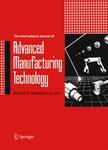版权所有:内蒙古大学图书馆 技术提供:维普资讯• 智图
内蒙古自治区呼和浩特市赛罕区大学西街235号 邮编: 010021

作者机构:Univ Windsor Dept Mech Automot & Mat Engn Sunset Ave Windsor ON N9B 3P4 Canada
出 版 物:《INTERNATIONAL JOURNAL OF ADVANCED MANUFACTURING TECHNOLOGY》 (国际先进制造技术杂志)
年 卷 期:2023年第126卷第5-6期
页 面:2745-2763页
核心收录:
学科分类:12[管理学] 1201[管理学-管理科学与工程(可授管理学、工学学位)] 08[工学] 0802[工学-机械工程] 0811[工学-控制科学与工程]
主 题:Directed energy deposition Thin wall geometry Multiple junctions Residual stress Numerical analyses Simulations Computational techniques
摘 要:Laser cladding is a directed energy deposition process and can lead to high residual stresses, which can compromise the quality of the specimen. As a result, it is crucial to accurately predict and investigate the residual stress distribution in cladded parts and understand the formation mechanisms. In this study, a thermo-mechanical metallurgical simulation model of the laser cladding process was developed for three different deposition sequences for a thin wall hexagon with inner junctions to investigate the formation of residual stress and distortion. The study was performed for single and multilayer scenarios. Two types of computational techniques, the detailed transient approach and the imposed thermal cycle approach, were performed and comparisons conducted. Consistent results were observed when comparing the resultant stress patterns for the single layer;subsequently, the imposed thermal cycle method was applied for the five-layer models. A preheat scenario is explored. This reduced the computational cost significantly, but the stress patterns were not similar. This indicates that building up worn regions at the top of a thin-walled component, such as a roll die, needs to be investigated further as unique issues have been highlighted. The differences between the implemented computational techniques are described as well as the advantages and disadvantages of each. Knowledge obtained from these case studies provides a foundation for efficient and rapid optimization of laser cladding processes, with the aim of minimizing residual stress in both simple and complex laser cladding structures.